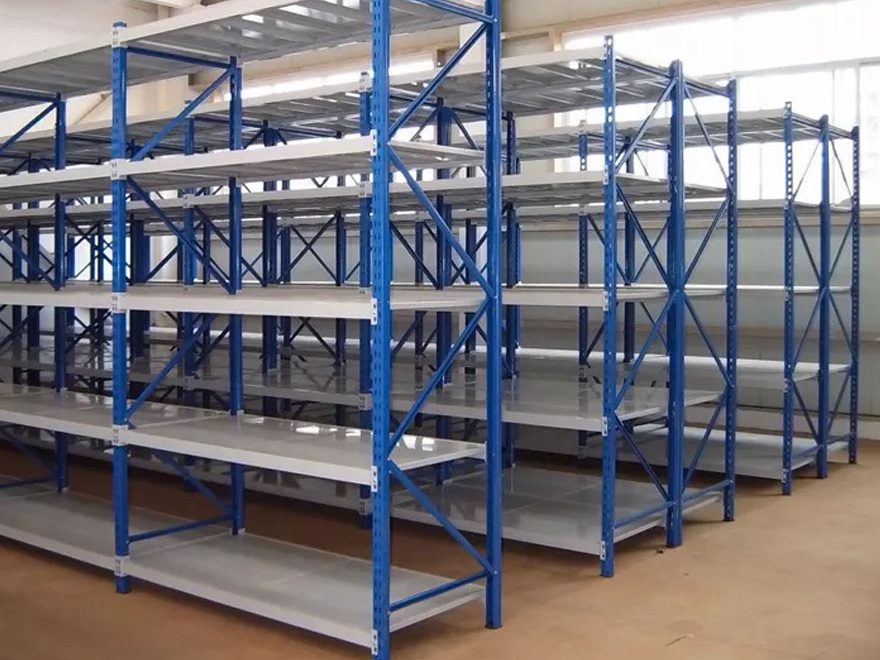Medium Duty Storage Racking
Medium Duty Racking
It is designed where goods are stored and removed manually from the Racks. It is best for storing small quantities of a large variety of product types.
 Medium Duty storage racking system is designed where goods are not handled in pallets , but stored and removed manually from the racking.
Medium Duty storage racking system is designed where goods are not handled in pallets , but stored and removed manually from the racking.
Additional features include galvanized steel shelf panels or medium duty shelving for traditional storage.
A variety of accessories, such as steel decks, partitions, wire mesh walls, etc., ensure the multi-functional use of this racking.
Medium duty racking system offers different construction arrangements, from simple modular racks to mezzanines and easily extendable raised tiers at different levels.
Advantages
- Storing boxes, packages or loose materials
- Adapts quickly and easily for any load configuration
- Extension is possible at any time
- Shelves are adjustable per 25/50mm in height
If you’re in need of a reliable and efficient solution for organizing your warehouse or workspace, then you’ve come to the right place. Medium duty racks system in Dubai is designed to provide sturdy support for your inventory, tools, equipment, or any other items that require proper organization and easy accessibility.
Definition and purpose of medium duty storage racking
One key advantage of medium duty storage racking is its adjustability. With adjustable shelves or beams, you have the flexibility to customize the rack configuration according to your specific needs. This allows you to efficiently store items of varying sizes without wasting any valuable space.
Medium duty storage racking provides an efficient industrial racking solution for optimizing space utilization while keeping your inventory organized and easily accessible. Whether you’re managing a small warehouse or setting up a workshop, these racks offer an affordable way to enhance productivity by eliminating clutter and improving workflow efficiency.
Types of materials used for medium duty racking.
When it comes to medium duty storage racking, various types of materials can be used depending on the specific needs and requirements of your warehouse or storage facility. These different materials offer varying levels of durability, strength, and cost-effectiveness.
Another material option is wire decking. Wire decking consists of metal wire mesh panels that are placed on top of beams to create shelf surfaces. This type of material allows medium duty rack for improved visibility and airflow while still providing support for items stored on the racks.
For those looking for a more economical option, particle board or plywood may be used as medium duty shelving materials. These materials are less expensive than steel but still provide adequate support for medium-duty storage needs.
Installation and maintenance tips for medium duty storage racking
Installation and maintenance are crucial aspects to consider when it comes to medium duty racks system in Dubai. Proper installation ensures the stability and durability of the racking system, while regular maintenance helps prolong its lifespan.
Before installing medium duty storage racking, it is essential to carefully plan the layout and design according to your specific needs. Consider factors such as available space, weight capacity requirements, and accessibility for easy retrieval of items.
Safety measures to follow when using medium duty storage racking
When it comes to using medium duty storage racking, safety should always be a top priority. Proper handling and maintenance of the racks can not only prevent accidents but also extend the lifespan of your storage system. Here are some essential safety measures for medium duty racks system in Dubai, UAE to follow:
1. Weight Capacity: One of the most important aspects of using medium duty storage racking is understanding its weight capacity. Each rack has a specific load-bearing capacity, so make sure you do not exceed this limit. Overloading the racks can lead to structural damage and potential collapse.
2. Proper Installation: Ensure that the racking system is installed correctly by hiring professionals for installation. This will ensure stability and minimize any risks associated with improper assembly.
3. Regular Inspections: Conduct regular inspections of your medium duty storage racking system to identify any signs of damage or wear and tear. Look out for bent beams, loose connections, or rusted components as these could compromise the integrity of the structure.
4. Load Distribution: Distribute loads evenly across each shelf or beam to maintain balance within the rack system. Placing heavier items in the lower levels will help prevent toppling over due to an unstable center of gravity.
5. Securely Fasten Items: Make sure all items stored on shelves are securely fastened or properly stacked to avoid them falling off and causing injuries or damages.
6. Forklift Safety: If you use forklifts in your warehouse, ensure that operators are trained in proper handling techniques when loading and unloading materials from medium duty storage racks.
7. Clear Aisles: Maintain clear aisles between rows of racks for easy access and safe movement within your warehouse space.
8. Training & Awareness : Educate employees about safe practices when working around medium duty storage racking systems including how they should handle heavy loads moving near or under shelving units


 FSC India
FSC India